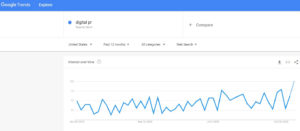

Years ago, prior to Google, social media, online reviews and the plethora of other internet marketing platforms, practices had limited options to credibly market their services. Most professoinal practices resisted advertising in the Yellow Pages, newspapers, magazines, billboards, or mass media due to high costs, but also because of concerns for the practice’s image.
Instead, the focus was on word-of-mouth marketing and earning “free exposure” through Public Relations (PR) and becoming an authority figure for media stations and newspapers. However, over the course of time, the popularity of traditional PR declined as quickly as marketing on the Internet grew. See Google’s search trend for Public Relations (2004-today), below.

Although interest in traditional PR has declined, the importance of earned media and credibility has not. In fact, it has become increasingly important in today’s digital marketing world. The fact is Public Relations never really went away; instead, it transformed to adjust to today’s online consumers, websites, and platforms. Referred to as Digital PR, it is taking on a much bigger role in today’s online marketing and advanced SEO strategies.
In fact, many of Google’s algorithm updates, including the May 2020 Core Update have been re-enforcing its emphasis on E-A-T (Expertise, Authoritativeness and Trustworthiness) ranking factors, which is also addressed in Google’s Search Quality Evaluator Guidelines.
These changes have broadened digital marketing and SEO thinking and now have practices revisiting and embracing Public Relations. Google Trends shows a particularly big increase in interest for Digital PR since the May update.

Digital PR is like traditional PR in that the underlying goal is to manage, enhance, and elevate the visibility, awareness, reputation and understanding of your practice and its brand through credible 3rd party sources.
Where PR focused simply on targeting stations and newspapers, Digital PR has expanded to also utilize a wider variety of platforms and digital media to create relationships with online journalists, influencers, bloggers, organizations, vendors and industry experts that are relevant to your business and local market.
In simple terms, the overall objective is to earn exposure, traffic and links across numerous platforms such as news, informational, industry and local community websites, blogs, social media, podcasts, business networks, etc.
A thorough address of Digital PR strategies goes well beyond what I can cover in a blog article and maintain most practice’s attention. However, to provide some hands-on tactics and things your practice can start implementing, here is a short list of some quick suggestions. Use them as starting points to craft your creative Digital PR marketing plan for 2021.
Digital PR has many direct and indirect benefits to businesses. Not only can it help improve your search engine visibility and rankings, but it also drives high-quality direct traffic, solidifies your online brand trust (Google favors brands), which enhances your ability to convert exposure into leads and leads into new clients.
If you would like a free assessment of your practice’s digital footprint and PR, call us at (202) 918-2450, or Contact Us.
Good Luck!